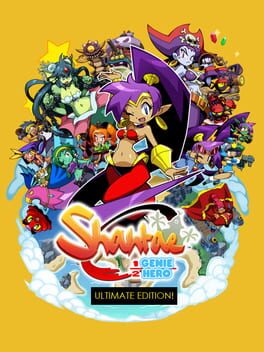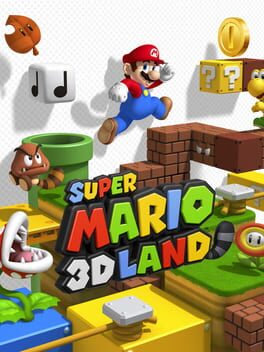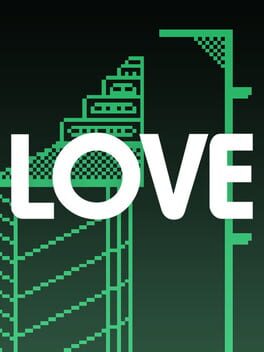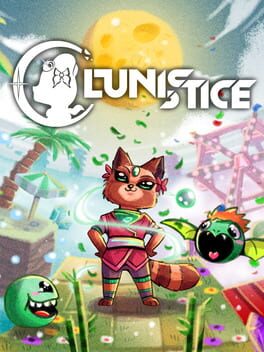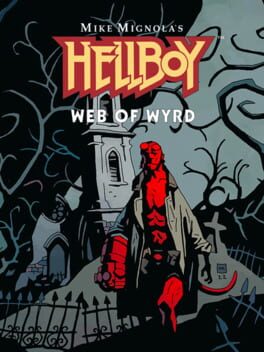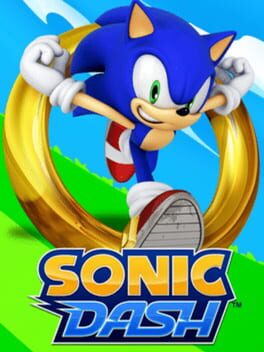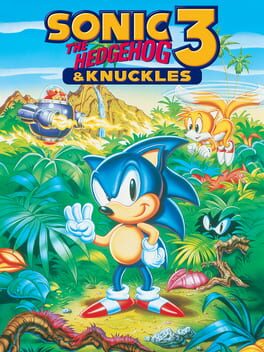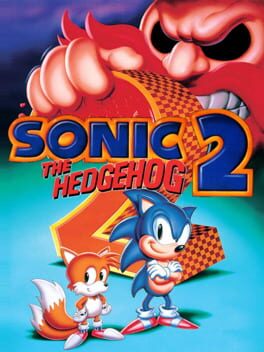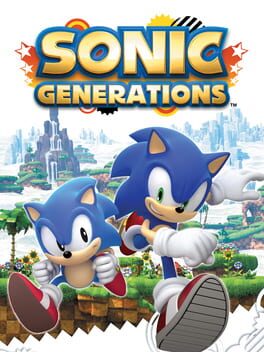MattCrossGames
In a sea of Sonic inspired games, and for that matter Sonic sequels, Penny's Big Breakaway is the first one I think that genuinely follows up on the principles of the Classic entries. Namely, that momentum is a must to be good at the game. Being put in the shoes of a newbie with zero momentum talent, but armed with a toy that shapes her into a platforming genius, is by far the best idea for a Sonic successor I can think of.
Penny has wonderfully layered level design and controls, resulting in a ton of possibilities to workshop a level. Granted, it may stumble onto some physics bugs and its story doesn't feel as cohesive as it potentially could be. But the fact is, they nailed it. They nailed a game where not only advanced players gotta learn momentum, but EVERYONE who plays the game. And overall, it makes me so damn happy seeing such a technical platformer both baffle and amaze gamers of today.
Penny has wonderfully layered level design and controls, resulting in a ton of possibilities to workshop a level. Granted, it may stumble onto some physics bugs and its story doesn't feel as cohesive as it potentially could be. But the fact is, they nailed it. They nailed a game where not only advanced players gotta learn momentum, but EVERYONE who plays the game. And overall, it makes me so damn happy seeing such a technical platformer both baffle and amaze gamers of today.
Part of me kinda wishes this was a straight up linear action game or platforming game. Of course, the platforming here is as sublime as the modern Rayman entries, but surprisingly, the combat of this game is excellent! I found myself getting really invested in upgrades, customizing my builds, and getting into random fights for fun and especially feeling great about the boss fights.
What holds it back is that this isn't a very cohesive Metroidvania to me. It's a very massive map, considering how it has to make room for the elaborate platforming challenges, and there isn't many opportunities for shortcuts in either the environment or the movement pool. Perhaps there's something I'm missing with the level design, but I just couldn't feel any rapport with it like I have with other Metroidvanias (and Metroid itself).
Still, I think it's totally worth a try for what the team is renowned for, and for a newfound strength of theirs! I'll always look forward to Ubi Montpellier's platforming games, but I really hope they delve further into combat-focused games from this point on, there's some exciting potential for that here!
What holds it back is that this isn't a very cohesive Metroidvania to me. It's a very massive map, considering how it has to make room for the elaborate platforming challenges, and there isn't many opportunities for shortcuts in either the environment or the movement pool. Perhaps there's something I'm missing with the level design, but I just couldn't feel any rapport with it like I have with other Metroidvanias (and Metroid itself).
Still, I think it's totally worth a try for what the team is renowned for, and for a newfound strength of theirs! I'll always look forward to Ubi Montpellier's platforming games, but I really hope they delve further into combat-focused games from this point on, there's some exciting potential for that here!
This was my first Shantae game, and it was pretty good! I can see how this more linear structured game might not jive with the Metroidvania style of these games, exploring and completion did feel a bit unnatural than I expected from this series. But for the most part I enjoyed clearing the levels and didn't mind too much having to backtrack for certain items between them, making for a solid any-percent run.
I think even the game realizes it's better off as a Mega Man style experience because its more arcadey DLC modes go for a more marathon-based progression, which make the game a lot more fun. Overall a good gateway game with a lot of heart put into its production and content that definitely made me more interested in the other core Shantae entries.
I think even the game realizes it's better off as a Mega Man style experience because its more arcadey DLC modes go for a more marathon-based progression, which make the game a lot more fun. Overall a good gateway game with a lot of heart put into its production and content that definitely made me more interested in the other core Shantae entries.
2024
2011
Gonna be real: this is the foundation for my PERFECT Mario game. Bite-sized Mario Galaxy level design meets 2D Mario running momentum & powerups. This makes for a game that's really fun to speedrun and play your own way, completion or otherwise! Also really dig how unique and out there some of the camera perspectives and stage concepts were as a result of being designed for the stereoscopic 3D.
Only things that hold it back from being perfect are a lack of total originality in the themes of the game and the acrobatic moves and potential from the previous 3D games. And whaddya know, the sequel testifies to both of those! But still, don't let the basic Mario look turn you off: this is an excessively fun Mario game and by far the best handheld entry in the series.
Only things that hold it back from being perfect are a lack of total originality in the themes of the game and the acrobatic moves and potential from the previous 3D games. And whaddya know, the sequel testifies to both of those! But still, don't let the basic Mario look turn you off: this is an excessively fun Mario game and by far the best handheld entry in the series.
1985
The world does not talk about Super Mario Bros. enough. Yes, everyone and their ancestors talks endlessly about the franchise it spawned - even the cultural importance of this starting entry - but I don't think there's enough widespread discussion about the actual game itself. Namely... that it's a pretty fun game in its own right!
One thing this game does really well is bring the "Super" factor into the gameplay. The original Mario Bros was a never-ending, single-screened plumbing graveyard shift of a game, but SUPER Mario Bros injects it with so much more flavor and adventure. A run button to control the speed and height of your platforming. Unique levels with secrets and power-ups for safe insurance. Wrapped into a playlist that you can marathon towards a genuine ending.
I always admired the challenge of this game. How you can plan every sprint and jump to both bypass the trickiest pits and plow through sections you're already familiar with. Dare I say, it's one of the few Mario games where I was genuinely invested in keeping my power ups to stand a better chance against late game foes, collecting coins and farming for lives, just so I could survive the rest of the road.
I'd say the most primitive things that hold back this starting entry are visual variety and some fine tuning with the controls. There's a reason that 1-1 theme is iconic, cause you're gonna experience it about 20+ times over from start to finish. And while I think the inclusion of a run button and momentum-driven mechanics are the real heart of the gameplay, it's not the smoothest it could be. Mario goes from a walk to a sprint in a seemingly geared fashion that throws me off pretty easily, hard to really set yourself reliably from a safe hop to a long jump without some blurred line in the engine messing you up.
But, cmon. For one of the most important video games in history, it's a damn good showcase of Nintendo's original talent and the potential and appeal of Mario going forward. Especially now when every new platformer is either crazy, speedy, or plain kaizo, it's nice to unwind with a straightforward game with simple mechanics to master and levels that are challenging enough but also open enough to just jungle gym around at your own pace. Maybe Mario would be more Super from this point on, but if there was one game that had to show the world the Super factor of gaming, I'm glad it turned out to be this one.
One thing this game does really well is bring the "Super" factor into the gameplay. The original Mario Bros was a never-ending, single-screened plumbing graveyard shift of a game, but SUPER Mario Bros injects it with so much more flavor and adventure. A run button to control the speed and height of your platforming. Unique levels with secrets and power-ups for safe insurance. Wrapped into a playlist that you can marathon towards a genuine ending.
I always admired the challenge of this game. How you can plan every sprint and jump to both bypass the trickiest pits and plow through sections you're already familiar with. Dare I say, it's one of the few Mario games where I was genuinely invested in keeping my power ups to stand a better chance against late game foes, collecting coins and farming for lives, just so I could survive the rest of the road.
I'd say the most primitive things that hold back this starting entry are visual variety and some fine tuning with the controls. There's a reason that 1-1 theme is iconic, cause you're gonna experience it about 20+ times over from start to finish. And while I think the inclusion of a run button and momentum-driven mechanics are the real heart of the gameplay, it's not the smoothest it could be. Mario goes from a walk to a sprint in a seemingly geared fashion that throws me off pretty easily, hard to really set yourself reliably from a safe hop to a long jump without some blurred line in the engine messing you up.
But, cmon. For one of the most important video games in history, it's a damn good showcase of Nintendo's original talent and the potential and appeal of Mario going forward. Especially now when every new platformer is either crazy, speedy, or plain kaizo, it's nice to unwind with a straightforward game with simple mechanics to master and levels that are challenging enough but also open enough to just jungle gym around at your own pace. Maybe Mario would be more Super from this point on, but if there was one game that had to show the world the Super factor of gaming, I'm glad it turned out to be this one.
2014
I liked Love! It's cool to thread the needle of your tiny 16-pixel man across levels so complex. Gives me the feeling of when I'd see diagrams on paper or buildings in the distance and imagine little guys doing platforming on them.
Honestly though, when the game isn't trying to shred your character to pieces, my favorite levels are the more open and abstract ones where you can just roam and get a feel for the unique architecture. The cave resembling a monster was a personal highlight. But for the most part, what you see is what you get. A minimalist platformer about preparing to die. Some tough death traps, some pretty cool scenery, some really interesting gimmicks... without much deliberation on any of these areas. Short and sweet. "Love" may not refer to how I personally feel about the game, but the miniscule craftsmanship of what they pulled in just a dozen or so levels is where the namesake really is.
Honestly though, when the game isn't trying to shred your character to pieces, my favorite levels are the more open and abstract ones where you can just roam and get a feel for the unique architecture. The cave resembling a monster was a personal highlight. But for the most part, what you see is what you get. A minimalist platformer about preparing to die. Some tough death traps, some pretty cool scenery, some really interesting gimmicks... without much deliberation on any of these areas. Short and sweet. "Love" may not refer to how I personally feel about the game, but the miniscule craftsmanship of what they pulled in just a dozen or so levels is where the namesake really is.
2022
A platformer that asks, "What if you could speedrun your wildest dreams?", and absolutely hits it out of the park (specifically the uncanny amusement park that your MC prolly once went to as a for real human).
Lunistice marries tight triple jumping and running momentum action with peaking and fragmented obstacle courses, resulting in an excellent speedrun-focused collect-a-thon. Has a really lovely mood of hopping around in dreams of places or memories you had in the past - with platforms feeling so disjointed and out of reach that may not initially look like they fit a coherent course... yet they totally do. Also love that the level design has both numerous opportunities for shortcuts while also weaving secret collectible areas so fluidly into its main paths. It's the kind of game where whether you're playing it fast, casually, or for completion, there's a continuous sense of momentum that you can always maintain.
It can be a real tough game to master its completion routes. I think the worst offender would have to be some of the collectible crane placements. Some of which are pretty well thought out for both guiding newbies and facilitating a fluent completionist route, while a handful of them are really easy to miss because of how they go against the intended flow. Frankly, nothing bites more than getting every feasible route down only to realize you missed one single crane just as you reached the exit. But getting past the grievances of S Rank perfectionism, the vibe and fluidity of the platforming here is unmatched. I've played plenty of speedy, earthly, and insanely difficult platformers, but rarely have I felt one as dreamy, snacky, and seamless to play as Lunistice.
Really looking forward to that DLC update. Also, Mario Galaxy wishes it had spin-jump platforming this excellent. Yeah, I said it.
Lunistice marries tight triple jumping and running momentum action with peaking and fragmented obstacle courses, resulting in an excellent speedrun-focused collect-a-thon. Has a really lovely mood of hopping around in dreams of places or memories you had in the past - with platforms feeling so disjointed and out of reach that may not initially look like they fit a coherent course... yet they totally do. Also love that the level design has both numerous opportunities for shortcuts while also weaving secret collectible areas so fluidly into its main paths. It's the kind of game where whether you're playing it fast, casually, or for completion, there's a continuous sense of momentum that you can always maintain.
It can be a real tough game to master its completion routes. I think the worst offender would have to be some of the collectible crane placements. Some of which are pretty well thought out for both guiding newbies and facilitating a fluent completionist route, while a handful of them are really easy to miss because of how they go against the intended flow. Frankly, nothing bites more than getting every feasible route down only to realize you missed one single crane just as you reached the exit. But getting past the grievances of S Rank perfectionism, the vibe and fluidity of the platforming here is unmatched. I've played plenty of speedy, earthly, and insanely difficult platformers, but rarely have I felt one as dreamy, snacky, and seamless to play as Lunistice.
Really looking forward to that DLC update. Also, Mario Galaxy wishes it had spin-jump platforming this excellent. Yeah, I said it.
2023
I've never wanted so badly to like a game more than this one. I don't know shit about Hellboy, but I would've told you that buying Web of Wyrd was worth it purely for how goddamn incredible that pugilist combat feels. Not the deepest action game, but the effects are really fun to play with. Longer combos for more damage, parrying to build up finishers, a dodge offset (one of the most surprising inclusions I've seen in a game that wasn't called Bayonetta!), and of course that satisfying BOOM punch. All coated in an incredible comic book graphical style.
Unfortunately the actual game is just insufficient to go through. Long stretches of halls you literally gotta trudge through. Roguelike elements that either don't really signal much of a change in your gameplay style or take you ages to get some decent upgrades to your builds. And prolly the worst thing is how much recycled content there is. And I mean, actual recycling. The penultimate chapter has you going through every previous dungeon again to take out generators. Then what does the home stretch entail? Going through every previous dungeon AGAIN to take out every generator AGAIN. In one perfect run. The moment I realized that I had to get through that to reach the final boss, the moment I felt like I had my fill.
That said, I still think I got my money's worth on some level - purely for how much fun I had with the combat. If what you see in trailer clips even remotely interests you, give it a go. I think there's an incredible game inside Web of Wyrd, just not really the one that we got currently.
Unfortunately the actual game is just insufficient to go through. Long stretches of halls you literally gotta trudge through. Roguelike elements that either don't really signal much of a change in your gameplay style or take you ages to get some decent upgrades to your builds. And prolly the worst thing is how much recycled content there is. And I mean, actual recycling. The penultimate chapter has you going through every previous dungeon again to take out generators. Then what does the home stretch entail? Going through every previous dungeon AGAIN to take out every generator AGAIN. In one perfect run. The moment I realized that I had to get through that to reach the final boss, the moment I felt like I had my fill.
That said, I still think I got my money's worth on some level - purely for how much fun I had with the combat. If what you see in trailer clips even remotely interests you, give it a go. I think there's an incredible game inside Web of Wyrd, just not really the one that we got currently.
2013
The only reason I installed this again was to have an excuse to play Seaside Hill while at a beachside vacation lol.
Anyway, it's not really my thing. Gameplay-wise, it's a pretty decent adaptation of the quick step parts of games like Unleashed and Generations to an endless runner, but the abundance of bullshit traps and farming schemes to unlock stuff just makes me zone out of it very quickly. Hopefully that Dream Team game scratches my itch for a 3D Sonic game on mobile that's genuinely completable and replayable.
Anyway, it's not really my thing. Gameplay-wise, it's a pretty decent adaptation of the quick step parts of games like Unleashed and Generations to an endless runner, but the abundance of bullshit traps and farming schemes to unlock stuff just makes me zone out of it very quickly. Hopefully that Dream Team game scratches my itch for a 3D Sonic game on mobile that's genuinely completable and replayable.
Two speedrunning entries and one artsy-er exploration take on Sonic later came the end of the trilogy: to put it simply, an "epic" take on the classic gameplay. Sonic 3 innovates the formula on two levels: an excellent core difficulty with the physics engine and an enthralling direction to take the campaign for a 16 bit platformer. If the previous entries made you appreciate how the speed of Sonic can flip the length and intended design of the game on its head, then Sonic 3 takes note of it and crafts a damn good challenge fit for the hedgehog. Angel Island is complex, devious, and at times even quaint in what enemies and obstacles it features. In retrospect, while the zone maps are gigantic compared to the previous games, the game is actually more linearly focused than you might remember. But it's all in the sport of a legitimate test of the game on a mechanical level, and not just to break the game in two. How proficient you can be in these back-to-back labyrinths that won't always privilege a fast track for you - in a way, a proper evolution of Sonic 1's philosophy!
You get more setpieces and escalations to zones that constantly keep you on your toes. The entrance to Angel Island is a decently dense jungle, until it gets set on fire and you have to drain out the waters to escape! Marble Garden is shifting and filled with spikebeds, then Eggman drills the area and you gotta make a run from the debris! Carnival Night gets the lights out treatment, Lava Reef Zone cools off and reveals the path to the Hidden Palace. Even the Chaos Emeralds have an extra challenge to upsize them into Super Emeralds and turn you into the illusive Hyper form! There's just an awesome progression, sense of exotic exploration and a genuine element of surprise in this game that couldn't have been achieved had it repurposed the speedrunning mindsets of games like Sonic 1 and 2.
That also might be the deciding factor of this game for some people, though. It's not a very fun game to time attack and going outside the intended path mostly leads to power ups and elemental shields, stuff made to arm yourself for the linear challenges ahead. Pretty much everyone who plays this game will encounter the same events in the campaign, and that may ruin the free spirit and creativity charm of Classic Sonic that defined the previous entries. In fact, one legitimate problem you have when setting a core campaign is how fair you make the challenges ahead, which 3 admittedly misses the mark on a couple of times. You're bound to get jettisoned or crushed or even confounded more than any other entry. For my money, the reason I came to love Sonic gameplay, especially the classic games, is the prospect of being cooler than the campaign you initially start with. But Sonic 3 was intentionally designed to humble the hedgehog, and at times even overwhelms his potential.
I've gone back and forth a lot towards how I feel about this. Initially, I hated this game. But I was a dumb kid who was bad at the game. Then, I grew to consider this game as 100% perfect and superior as a legitimately challenging Classic Sonic game. At some point, though, I missed having those streetwise opportunities to be cooler than the level design that the previous numbered entries, and even CD, were emblematic of. But I think in the end, I can say that this is an excellent centerpiece and better suited as the finish line of the Classic Sonic formula. An adventure worth going through, if not every now and then. Not as highly replayable or arcade-y as previous games, but a treasure of a journey you gotta experience with Sonic at least once in your lifetime. No other time in a 2D Sonic game, let alone any 2D game, will you get an interconnected, consistently perplexing/challenging and once again, EPIC platformer like this one. And while I may prefer the more freeform and expansive takes on this formula that would come down the road, there is only one Sonic 3 & Knuckles in this world. Sonic's biggest challenge yet, for better and for worse, but one you absolutely have to see through to the edge of Doomsday Zone every time.
You get more setpieces and escalations to zones that constantly keep you on your toes. The entrance to Angel Island is a decently dense jungle, until it gets set on fire and you have to drain out the waters to escape! Marble Garden is shifting and filled with spikebeds, then Eggman drills the area and you gotta make a run from the debris! Carnival Night gets the lights out treatment, Lava Reef Zone cools off and reveals the path to the Hidden Palace. Even the Chaos Emeralds have an extra challenge to upsize them into Super Emeralds and turn you into the illusive Hyper form! There's just an awesome progression, sense of exotic exploration and a genuine element of surprise in this game that couldn't have been achieved had it repurposed the speedrunning mindsets of games like Sonic 1 and 2.
That also might be the deciding factor of this game for some people, though. It's not a very fun game to time attack and going outside the intended path mostly leads to power ups and elemental shields, stuff made to arm yourself for the linear challenges ahead. Pretty much everyone who plays this game will encounter the same events in the campaign, and that may ruin the free spirit and creativity charm of Classic Sonic that defined the previous entries. In fact, one legitimate problem you have when setting a core campaign is how fair you make the challenges ahead, which 3 admittedly misses the mark on a couple of times. You're bound to get jettisoned or crushed or even confounded more than any other entry. For my money, the reason I came to love Sonic gameplay, especially the classic games, is the prospect of being cooler than the campaign you initially start with. But Sonic 3 was intentionally designed to humble the hedgehog, and at times even overwhelms his potential.
I've gone back and forth a lot towards how I feel about this. Initially, I hated this game. But I was a dumb kid who was bad at the game. Then, I grew to consider this game as 100% perfect and superior as a legitimately challenging Classic Sonic game. At some point, though, I missed having those streetwise opportunities to be cooler than the level design that the previous numbered entries, and even CD, were emblematic of. But I think in the end, I can say that this is an excellent centerpiece and better suited as the finish line of the Classic Sonic formula. An adventure worth going through, if not every now and then. Not as highly replayable or arcade-y as previous games, but a treasure of a journey you gotta experience with Sonic at least once in your lifetime. No other time in a 2D Sonic game, let alone any 2D game, will you get an interconnected, consistently perplexing/challenging and once again, EPIC platformer like this one. And while I may prefer the more freeform and expansive takes on this formula that would come down the road, there is only one Sonic 3 & Knuckles in this world. Sonic's biggest challenge yet, for better and for worse, but one you absolutely have to see through to the edge of Doomsday Zone every time.
2023
Pretty great follow-up to Smooth Moves! On top of a charming vacation aesthetic, this sequel's biggest innovation to gameplay is that instead of playing microgames with one semi-precise Form Baton, you now have two ultra-precise Form Stones!
As a result, Move It has some of the best designed sets of microgames in the series so far - now that it gets to work with a wilder and more complex field of motions. Sure, you'll get the lousy easier microgames where spamming or pulling a single trick is all you need to do, a problem that I've had with the more gimmicky WarioWare sequels in the past. But I was pleasantly surprised by the heftier number of more challenging, skill-based, and dare I say, video game-ier, microgames here! Like using the torque of your hips to solve an intestinal maze, or using the goddamn IR sensor to play rock paper scissors, or using the Joycons as maracas or guitars to play a precise rhythm game. And pretty much everything about the endgame dance party was exactly what I wanted from a Smooth Moves sequel. It's not only a decent work out, but it also gave me flashbacks to the potential of the very first WarioWare, whose microgames felt like entering into a fully fledged video game for a magical brief moment in time. I haven't really felt that spark from the controller gimmick WarioWares, not even from Smooth Moves admittedly, but Move It surprised me with how it went for the gold! It made me see the motion controls less as a tech demo for lol gags but as a tool to jump into brief puzzle-action - and even virtual reality - level vignettes.
The only thing that holds it back as a spectacular WarioWare and the one area where it pales as a sequel to Smooth Moves is a lack of bonus single player content. The main campaign is hella replayable and there are a few fun unlocks, but you can't help but feel that the rest of the game's creative energies outside of microgames are being displaced in a distant multiplayer mode. Hell, it's literally an island isolated from the story mode. If you're in a pad with a set of friends commonly nearby, then this game will be a real gem to personally own. But I'm surprised there weren't even single player missions or collectibles to obtain along the way of the story. I understand it's because they want to market WarioWare as THE go-to party game, but I really hope that ghosting single player bonus content doesn't become a standard for the series like it has been here.
Regardless, Move It is a really swell time. On the whole, content and core gameplay-wise, I think I find the previous Get it Together to be a much better WarioWare sequel, but this one has redeemed a lot of passive interest I've had in the sequels to this series. It's by far the best gimmick-based WarioWare game and arguably the best honest-to-god EXCLUSIVE for the Switch - a game you physically cannot play or get anywhere else. Also, gotta give all the credit in the world to a Switch game that actually makes me want to use the Joycons.
As a result, Move It has some of the best designed sets of microgames in the series so far - now that it gets to work with a wilder and more complex field of motions. Sure, you'll get the lousy easier microgames where spamming or pulling a single trick is all you need to do, a problem that I've had with the more gimmicky WarioWare sequels in the past. But I was pleasantly surprised by the heftier number of more challenging, skill-based, and dare I say, video game-ier, microgames here! Like using the torque of your hips to solve an intestinal maze, or using the goddamn IR sensor to play rock paper scissors, or using the Joycons as maracas or guitars to play a precise rhythm game. And pretty much everything about the endgame dance party was exactly what I wanted from a Smooth Moves sequel. It's not only a decent work out, but it also gave me flashbacks to the potential of the very first WarioWare, whose microgames felt like entering into a fully fledged video game for a magical brief moment in time. I haven't really felt that spark from the controller gimmick WarioWares, not even from Smooth Moves admittedly, but Move It surprised me with how it went for the gold! It made me see the motion controls less as a tech demo for lol gags but as a tool to jump into brief puzzle-action - and even virtual reality - level vignettes.
The only thing that holds it back as a spectacular WarioWare and the one area where it pales as a sequel to Smooth Moves is a lack of bonus single player content. The main campaign is hella replayable and there are a few fun unlocks, but you can't help but feel that the rest of the game's creative energies outside of microgames are being displaced in a distant multiplayer mode. Hell, it's literally an island isolated from the story mode. If you're in a pad with a set of friends commonly nearby, then this game will be a real gem to personally own. But I'm surprised there weren't even single player missions or collectibles to obtain along the way of the story. I understand it's because they want to market WarioWare as THE go-to party game, but I really hope that ghosting single player bonus content doesn't become a standard for the series like it has been here.
Regardless, Move It is a really swell time. On the whole, content and core gameplay-wise, I think I find the previous Get it Together to be a much better WarioWare sequel, but this one has redeemed a lot of passive interest I've had in the sequels to this series. It's by far the best gimmick-based WarioWare game and arguably the best honest-to-god EXCLUSIVE for the Switch - a game you physically cannot play or get anywhere else. Also, gotta give all the credit in the world to a Switch game that actually makes me want to use the Joycons.
1992
If Sonic 1 was a speedrunning subversion of your typical old-school platformer, then its sequel lets the sheer superspeed of the character steal the show! Iterating on the tier-based level design of Green Hill for almost all of its zones, Sonic 2 rewards those who can think cleverly with Sonic's pinball momentum on the highest grounds with the most blistering speed you've ever seen a video game avatar go through. It's hard not to be mesmerized on first impression and on repeat runs when you really figure out how to let this physics engine go wild. Even the camera starts to lose track of what the devs managed to unleash here!
It's a quintessential romp that's super easy to pick up and play - the purest reminder to me of the general appeal of Sonic's spectacle. That said, to say it's substantially better - or even worse - than Sonic 1 hasn't been something that's exactly computed with me. One major thing about giving easier chances to break the sound barrier with Sonic is a higher skill ceiling, which is excellent, but also a downgrade in base difficulty. I felt that earning speed in Sonic 1 wasn't just something you were selectively given, but a necessity to learn and thus overcome some of the worst and most punishing parts of that game. Not even just learning the momentum, but being streetwise with shortcuts and bypasses was an extremely clever way to interpret the "speedy" thinking of Sonic, subverting a platforming character who would just arbitrarily take a tough obstacle course at face value. Sonic 2, meanwhile, is constantly granting you momentum chances. It's hard not to miss them, even when you're not taking the top paths! This makes for a game that definitely shines in the advanced speedrunning department, seeing how fast you can beat the game, but it also means there isn't much of a hurdle to really struggle or learn why the physics engine is integral to the character. The world is kinda pre-built for him to be awesomely fast. A great fantasy to embody, but I think the importance of Sonic's super speed was represented better in the first outing - and for that matter, Classic Sonic entries beyond this one.
That also said, I've grown some appreciation (and also some frustration) for the more nuanced parts of the game! The initial zones are all a passing blur to me, but I ended up really feeling for the more esoteric and trickier zones like Mystic Cave, Oil Ocean and Wing Fortress. These feel more like evolved iterations of Sonic 1's philosophy, which I liked a lot! I also gotta give credit to this sequel's badass endgame - a calm before the storm where you fly the Tornado with your new pal Tails to breach a flying fortress, hitching a ride to invade the Death Egg in space, and destroying the Death Egg Robot - what feels at first like the most immutable death trap imaginable, but ultimately a scrap of metal you manage to beat with zero rings. Incredible stuff.
Sonic 2 has the highs and lows of any solid on-foot marathon. It's fun to keep up the pace, it can kinda dull you out on how you're limited to nothing but a jog, but pushing yourself to the end makes it all worthwhile. It's one of the first games I think of when I think of a pocket game that I can beat in a solid 30 minutes. I may not completely vibe with the idea of Sonic being a constant blue blur, but it's a power trip worth appreciating every now and then.
It's a quintessential romp that's super easy to pick up and play - the purest reminder to me of the general appeal of Sonic's spectacle. That said, to say it's substantially better - or even worse - than Sonic 1 hasn't been something that's exactly computed with me. One major thing about giving easier chances to break the sound barrier with Sonic is a higher skill ceiling, which is excellent, but also a downgrade in base difficulty. I felt that earning speed in Sonic 1 wasn't just something you were selectively given, but a necessity to learn and thus overcome some of the worst and most punishing parts of that game. Not even just learning the momentum, but being streetwise with shortcuts and bypasses was an extremely clever way to interpret the "speedy" thinking of Sonic, subverting a platforming character who would just arbitrarily take a tough obstacle course at face value. Sonic 2, meanwhile, is constantly granting you momentum chances. It's hard not to miss them, even when you're not taking the top paths! This makes for a game that definitely shines in the advanced speedrunning department, seeing how fast you can beat the game, but it also means there isn't much of a hurdle to really struggle or learn why the physics engine is integral to the character. The world is kinda pre-built for him to be awesomely fast. A great fantasy to embody, but I think the importance of Sonic's super speed was represented better in the first outing - and for that matter, Classic Sonic entries beyond this one.
That also said, I've grown some appreciation (and also some frustration) for the more nuanced parts of the game! The initial zones are all a passing blur to me, but I ended up really feeling for the more esoteric and trickier zones like Mystic Cave, Oil Ocean and Wing Fortress. These feel more like evolved iterations of Sonic 1's philosophy, which I liked a lot! I also gotta give credit to this sequel's badass endgame - a calm before the storm where you fly the Tornado with your new pal Tails to breach a flying fortress, hitching a ride to invade the Death Egg in space, and destroying the Death Egg Robot - what feels at first like the most immutable death trap imaginable, but ultimately a scrap of metal you manage to beat with zero rings. Incredible stuff.
Sonic 2 has the highs and lows of any solid on-foot marathon. It's fun to keep up the pace, it can kinda dull you out on how you're limited to nothing but a jog, but pushing yourself to the end makes it all worthwhile. It's one of the first games I think of when I think of a pocket game that I can beat in a solid 30 minutes. I may not completely vibe with the idea of Sonic being a constant blue blur, but it's a power trip worth appreciating every now and then.
2023
I learned my lesson: I will never underestimate a new Classic Sonic entry ever again. I don't know how on earth I managed to convince myself that another genuine shot at one of my favorite platforming sciences of all time - iterative, innovative, or whatever in between - would be nothing more than "one of the 2D Sonic games of all time."
And yet here we are. I beat the main campaign, the outrageous extra mode, the jumpscare of a Last Story segment, all the while still conjuring up countless experimental runs, time trial strategies, and above all chill visits to smell the roses of each and every zone here. I positively loved this game. Not just on principal of the tried and true formula it's aping off, but what they've managed to achieve here with it. On the surface, we have a 2.5D take on Classic with a heavier emphasis on gimmicks, power ups, and boss battles. But cut a bit deeper and the real identity of this particular entry starts to unfold. A Classic Sonic game that returns to surrealist moments and imagery, esoteric and toylike contraptions at every corner, paired with the new age insight to elevate the player's progression through Chaos Emerald abilities and above all crafting one of the more genuinely challenging and action packed Sonic sidescrolling adventures you'll ever play.
It's exactly the kind of follow-up I wanted after Mania. That game did a great job summarizing the best of games like CD, 2, and 3K. And while there are some obstacles, wholesale zone themes, and playstyles that also remind me of those games, I would say on the whole the way I approach Superstars feels like no other Classic Sonic entry. I get the nostalgic urge to find the most optimal routes - often at the less treacherous top path a la Sonic 2 - but I also find myself getting curious with what's tucked away at any remote corner. I find myself wrestling with a zone's habit and assessing how to cope with it or eventually how to optimize it to my benefit. Bridge Island Zone has these floating bridge tubes at almost every ramp liftoff, but what if I cut some time to catch the midair ones? What if I hop off the accelerating vines of Speed Jungle to give myself a better liftoff? Or hop off the wobbly snake of Sand Sanctuary at the right time? Or pick up the pace so I can reset the doomsday alarm in Press Factory? This is where I think the game nails a unique sense of casual curiosity, challenge and optimization. You can soak the scenery and see what domino effects (or needlemouse traps) are populating the act. The later zones really put the pressure on you to learn what street language they're speaking or get lost in the dust. Then eventually, you challenge yourself to learn how to get through an act in one piece, or with a skillful amount of enemy hits and rings, until you inevitably reach the mindset where you wanna find the fastest, even the most subconcious ways - to speed through these labyrinths with finesse. I think it says a lot that the game gives you emerald powers that balance both exploration and movement streamlining itches. Not to mention, we have a Classic Sonic game that FINALLY acknowledges both time AND score attack records!
I think the new paradigm they brought to Classic Sonic here is fantastic, but it's clear there's some cohesion left in the mix, too. I openly agree that the game's overall quality - level design and presentation wise - is glaringly all over the place. Some zones look stunningly lavish while others look distractingly empty or cookie cutter. Some zones will have 2-3 acts while others will just be one dedicated act. The story will have some great character moments while also feeling like it skips on several important beats where you feel a bit lost on what exactly the overarching plot is supposed to be. Some bosses will have phases you can bypass with skill while others will force you to sit your ass on the waiting room to land on their hitbox. I will admit the one mismatch I do genuinely like is the soundtrack. We get a megamix of composers here and while I don't love every single track, I do respect hearing a wide range of 2D Sonic music talent.
Do I think the game could've delivered on its wackier, punchier and 3D graphical take on Classic Sonic with a more consistent or eye-catching level of quality? One hundred percent. But that said, even through the underwhelming or frustrating, that core still spoke loud and clear to me. It can be debated whether this is better or worse than Mania or the previous games (for me, the fact that I even think of it in the same ballpark of creativity as the masterful CD says a lot), but what I love about Superstars is that it is NOT Sonic Mania 2 nor Sonic 4 or 5. It has an identity of its own, its own lows and its own highs. And while I do agree that the game should've cooked a bit more to communicate this better, I think the highs will definitely reach you if you're even the slightest bit open minded to the idea of innovating or revisiting Classic Sonic action.
It's the kind of game that I should've known would've been a hole in one for me: a game with zones to glean and speedrun, a playlist to headbang or get tickled with the funny compositions, a set of characters you can freely choose between every act (including character exclusive acts being a great addition to mix up the campaign!). It's a Classic Sonic game in 2023. A game I'll obsess about playing for more than I probably should, one whose criticisms are definitely there and hold some weight, but ultimately are a result of a game whose take on a beloved formula was one that I vibed with insanely hard.
And yet here we are. I beat the main campaign, the outrageous extra mode, the jumpscare of a Last Story segment, all the while still conjuring up countless experimental runs, time trial strategies, and above all chill visits to smell the roses of each and every zone here. I positively loved this game. Not just on principal of the tried and true formula it's aping off, but what they've managed to achieve here with it. On the surface, we have a 2.5D take on Classic with a heavier emphasis on gimmicks, power ups, and boss battles. But cut a bit deeper and the real identity of this particular entry starts to unfold. A Classic Sonic game that returns to surrealist moments and imagery, esoteric and toylike contraptions at every corner, paired with the new age insight to elevate the player's progression through Chaos Emerald abilities and above all crafting one of the more genuinely challenging and action packed Sonic sidescrolling adventures you'll ever play.
It's exactly the kind of follow-up I wanted after Mania. That game did a great job summarizing the best of games like CD, 2, and 3K. And while there are some obstacles, wholesale zone themes, and playstyles that also remind me of those games, I would say on the whole the way I approach Superstars feels like no other Classic Sonic entry. I get the nostalgic urge to find the most optimal routes - often at the less treacherous top path a la Sonic 2 - but I also find myself getting curious with what's tucked away at any remote corner. I find myself wrestling with a zone's habit and assessing how to cope with it or eventually how to optimize it to my benefit. Bridge Island Zone has these floating bridge tubes at almost every ramp liftoff, but what if I cut some time to catch the midair ones? What if I hop off the accelerating vines of Speed Jungle to give myself a better liftoff? Or hop off the wobbly snake of Sand Sanctuary at the right time? Or pick up the pace so I can reset the doomsday alarm in Press Factory? This is where I think the game nails a unique sense of casual curiosity, challenge and optimization. You can soak the scenery and see what domino effects (or needlemouse traps) are populating the act. The later zones really put the pressure on you to learn what street language they're speaking or get lost in the dust. Then eventually, you challenge yourself to learn how to get through an act in one piece, or with a skillful amount of enemy hits and rings, until you inevitably reach the mindset where you wanna find the fastest, even the most subconcious ways - to speed through these labyrinths with finesse. I think it says a lot that the game gives you emerald powers that balance both exploration and movement streamlining itches. Not to mention, we have a Classic Sonic game that FINALLY acknowledges both time AND score attack records!
I think the new paradigm they brought to Classic Sonic here is fantastic, but it's clear there's some cohesion left in the mix, too. I openly agree that the game's overall quality - level design and presentation wise - is glaringly all over the place. Some zones look stunningly lavish while others look distractingly empty or cookie cutter. Some zones will have 2-3 acts while others will just be one dedicated act. The story will have some great character moments while also feeling like it skips on several important beats where you feel a bit lost on what exactly the overarching plot is supposed to be. Some bosses will have phases you can bypass with skill while others will force you to sit your ass on the waiting room to land on their hitbox. I will admit the one mismatch I do genuinely like is the soundtrack. We get a megamix of composers here and while I don't love every single track, I do respect hearing a wide range of 2D Sonic music talent.
Do I think the game could've delivered on its wackier, punchier and 3D graphical take on Classic Sonic with a more consistent or eye-catching level of quality? One hundred percent. But that said, even through the underwhelming or frustrating, that core still spoke loud and clear to me. It can be debated whether this is better or worse than Mania or the previous games (for me, the fact that I even think of it in the same ballpark of creativity as the masterful CD says a lot), but what I love about Superstars is that it is NOT Sonic Mania 2 nor Sonic 4 or 5. It has an identity of its own, its own lows and its own highs. And while I do agree that the game should've cooked a bit more to communicate this better, I think the highs will definitely reach you if you're even the slightest bit open minded to the idea of innovating or revisiting Classic Sonic action.
It's the kind of game that I should've known would've been a hole in one for me: a game with zones to glean and speedrun, a playlist to headbang or get tickled with the funny compositions, a set of characters you can freely choose between every act (including character exclusive acts being a great addition to mix up the campaign!). It's a Classic Sonic game in 2023. A game I'll obsess about playing for more than I probably should, one whose criticisms are definitely there and hold some weight, but ultimately are a result of a game whose take on a beloved formula was one that I vibed with insanely hard.
2011
Yup, those cutscenes are pretty cringe. Anyways, if Colors was my favorite take on the modern Boost gameplay, then Generations is my favorite take on the core Sonic experience: a platformer about being cooler than whatever platforming land you find yourself in. Generations achieves this not just with brilliant level design on its own, with layers of platforming lined with advanced shortcuts and fast track opportunities, but through the heart of its project. A celebratory title that doesn't just want to remind you about 20 years of Sonic, but to take its select highlights and remake them into the coolest versions of themselves possible.
This prospect of "remaking Sonic history" can be felt pretty much in every playable aspect of the game. Classic Sonic gets revamped with dynamic camerwork and setpieces and a powerful take on the spindash, but all the while renewing his original appeal of streetsmart platforming and momentum habits. Even the modern boost formula gets an excellent redux as a gameplay style where platforming and stopgaps are abundant, the boost feels like a hazardous powerup that won't always grant you an easy sprint through a level, but learning to channel both areas makes for some of the best skill ceilings you'll ever get from Sonic. Modern Sonic's action thriller vibes are carried over to Classic's gameplay while Classic Sonic's grounded and subversive sense of speed influences Modern's gameplay. Even the level selection has this initiative to think outside the box of their original concepts. What if Green Hill Zone was like a daytime continent from Unleashed? What if Chemical Plant was treated like a hazardous factory meltdown? What if Sky Sanctuary was an ACTUAL full level? You get all sorts of eye-opening revelations about places you once knew: the hotels in Speed Highway, the parks and downtown districts of City Escape, the once bottomless pit waters of Seaside Hill now being essential to advanced shortcuts, getting to visit the tornado carrying cars in Crisis City, going through the Werehog clocktower segment of Spagonia as a daytime Sonic, and getting a consolidation of Planet Wisps acts into one climb of a level. Every level feels like a complete zone - the ones that were already big layered zones feel even larger in scope and the more constrained modern levels get some much-needed depth to them. Entering a Generations zone now has a ton of gameplay attitudes to potentially approach them, paired with plenty of optional challenges that expand and get crazier with the ideas if you've had your fill with the base levels already.
This isn't one my favorite Sonic games because I necessarily think all the choices they picked for each era are pitch perfect. Nor is it my favorite because the gameplay is flawless. I don't really like the final boss. This is one of my all time favorites because it fires on all cylinders the sheer appeal of Sonic: to be cooler and cooler than the last place you start from. And whether it's doing a complete playthrough or just a marathon of every act on a whim, that sensation of being cooler is always prevalent in Generations. There are many cool Sonic games, but this one definitively tells the world that this character is, was, and always should be, about one-upping yourself.
This prospect of "remaking Sonic history" can be felt pretty much in every playable aspect of the game. Classic Sonic gets revamped with dynamic camerwork and setpieces and a powerful take on the spindash, but all the while renewing his original appeal of streetsmart platforming and momentum habits. Even the modern boost formula gets an excellent redux as a gameplay style where platforming and stopgaps are abundant, the boost feels like a hazardous powerup that won't always grant you an easy sprint through a level, but learning to channel both areas makes for some of the best skill ceilings you'll ever get from Sonic. Modern Sonic's action thriller vibes are carried over to Classic's gameplay while Classic Sonic's grounded and subversive sense of speed influences Modern's gameplay. Even the level selection has this initiative to think outside the box of their original concepts. What if Green Hill Zone was like a daytime continent from Unleashed? What if Chemical Plant was treated like a hazardous factory meltdown? What if Sky Sanctuary was an ACTUAL full level? You get all sorts of eye-opening revelations about places you once knew: the hotels in Speed Highway, the parks and downtown districts of City Escape, the once bottomless pit waters of Seaside Hill now being essential to advanced shortcuts, getting to visit the tornado carrying cars in Crisis City, going through the Werehog clocktower segment of Spagonia as a daytime Sonic, and getting a consolidation of Planet Wisps acts into one climb of a level. Every level feels like a complete zone - the ones that were already big layered zones feel even larger in scope and the more constrained modern levels get some much-needed depth to them. Entering a Generations zone now has a ton of gameplay attitudes to potentially approach them, paired with plenty of optional challenges that expand and get crazier with the ideas if you've had your fill with the base levels already.
This isn't one my favorite Sonic games because I necessarily think all the choices they picked for each era are pitch perfect. Nor is it my favorite because the gameplay is flawless. I don't really like the final boss. This is one of my all time favorites because it fires on all cylinders the sheer appeal of Sonic: to be cooler and cooler than the last place you start from. And whether it's doing a complete playthrough or just a marathon of every act on a whim, that sensation of being cooler is always prevalent in Generations. There are many cool Sonic games, but this one definitively tells the world that this character is, was, and always should be, about one-upping yourself.


